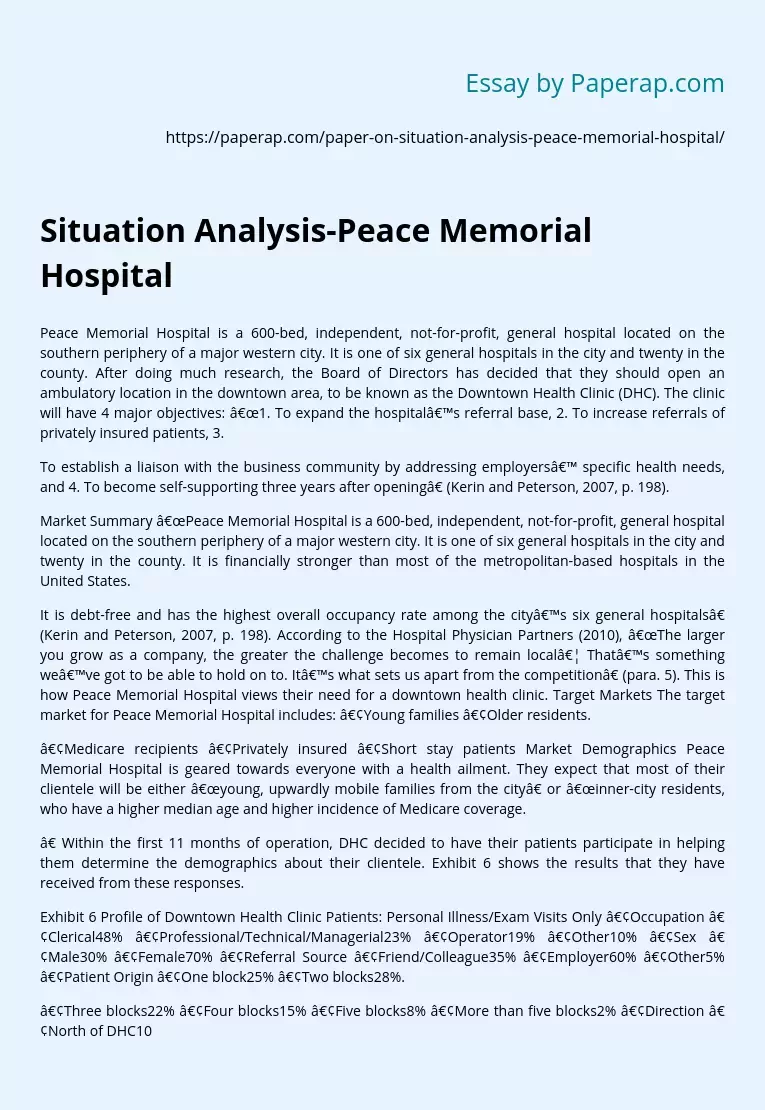Situation Analysis-Peace Memorial Hospital
Peace Memorial Hospital is a 600-bed, independent, not-for-profit, general hospital located on the southern periphery of a major western city. It is one of six general hospitals in the city and twenty in the county. After doing much research, the Board of Directors has decided that they should open an ambulatory location in the downtown area, to be known as the Downtown Health Clinic (DHC). The clinic will have 4 major objectives: “1. To expand the hospital’s referral base, 2. To increase referrals of privately insured patients, 3.
To establish a liaison with the business community by addressing employers’ specific health needs, and 4. To become self-supporting three years after opening” (Kerin and Peterson, 2007, p. 198).
Market Summary “Peace Memorial Hospital is a 600-bed, independent, not-for-profit, general hospital located on the southern periphery of a major western city. It is one of six general hospitals in the city and twenty in the county. It is financially stronger than most of the metropolitan-based hospitals in the United States.
It is debt-free and has the highest overall occupancy rate among the city’s six general hospitals” (Kerin and Peterson, 2007, p. 198). According to the Hospital Physician Partners (2010), “The larger you grow as a company, the greater the challenge becomes to remain local… That’s something we’ve got to be able to hold on to. It’s what sets us apart from the competition” (para. 5). This is how Peace Memorial Hospital views their need for a downtown health clinic. Target Markets The target market for Peace Memorial Hospital includes: •Young families •Older residents.
•Medicare recipients •Privately insured •Short stay patients Market Demographics Peace Memorial Hospital is geared towards everyone with a health ailment. They expect that most of their clientele will be either “young, upwardly mobile families from the city” or “inner-city residents, who have a higher median age and higher incidence of Medicare coverage.
” Within the first 11 months of operation, DHC decided to have their patients participate in helping them determine the demographics about their clientele. Exhibit 6 shows the results that they have received from these responses.
Exhibit 6 Profile of Downtown Health Clinic Patients: Personal Illness/Exam Visits Only •Occupation •Clerical48% •Professional/Technical/Managerial23% •Operator19% •Other10% •Sex •Male30% •Female70% •Referral Source •Friend/Colleague35% •Employer60% •Other5% •Patient Origin •One block25% •Two blocks28%.
•Three blocks22% •Four blocks15% •Five blocks8% •More than five blocks2% •Direction •North of DHC10% •South of DHC25% •Northeast of DHC5% •Southwest of DHC15% •East of DHC20% •West of DHC10% •Southeast of DHC10% •Northwest of DHC5% •Have Regular Physician •Yes18%
•No82% Market Needs “Given their [Suburban Ambulatory Care Clinics] locations in suburban areas, these facilities were not considered direct competition, but their existence indicated that “the city’s populace was attuned to ambulatory health care facilities,” (Kerin and Peterson, 2007, p. 200).
Exhibit 4 Suburban Ambulatory Care Clinics: Operations Profile OperationsEmer Center #1Emer Center #2Adams Industrial ClinicHealth FirstMedcenter OpeningMarch 1990November 1992June 1992May 1991June 1997 Patients/year9,0306,0008,4005,7008,661 Hours of operation10:00 A.
M. –10:00 P. M. 10:00 A. M. –10:00 P. M. 8:00 A. M. –5:00 P. M. 5:00 P. M. –11:00 P. M. 8:00 A. M. –8:00 P. M. Monday–FridayMonday–SundayMonday–FridayMonday–FridayMonday–Sunday 10:00 A. M. –10:00 P. M Saturday–Sunday Physicians/8-hr shift22222 Estimated patient visits/hour3. 8/hr3.
4/hr5. 0/hr3. 0/hr3. 0/hr Estimated average charge per visit$60. 00$62. 00$76. 00$62. 00$64. 00 Services provided: •Preventive health care XXX •Minor emergencies XXXXX •Employer services X •X-ray/lab tests XXXXX •Misc. XXXXX Use direct-mail advertisingXXXX Market Growth.
As Federal legislation has been introduced and altered, the hospital industry has started to thrive. “The Hill-Burton Act provided billions of dollars for hospital construction, to be repaid by fulfilling quotas for charity care. Additional funds were poured into expansion and construction of medical schools. Medicare and Medicaid subsidized health care for the indigent, disabled, and elderly. These programs reimbursed hospitals for their incurred costs plus an additional return on investment” (Kerin and Peterson, 2007, p. 196). SWOT Analysis.
Strengths: •Location Weaknesses: •Unemployment causing loss of health coverage Opportunities: •More Medicare recipients Threats: •Ambulatory health care services •Higher health premiums ? References Kerin, R. A. , & Peterson, R. A. (2007). Strategic marketing problems: Cases and comments (11th ed. ). Upper Saddle River, NJ: Pearson. Hospital Physician Partners. (2010). Rapid Growth Continues in 2010 for Hospital Physician Partners. Retrieved from http://www. hppartners. com/news/rapid-growth-continues-in-2010-for-hospital-physician-partners/.
Situation Analysis-Peace Memorial Hospital. (2018, Oct 06). Retrieved from https://paperap.com/paper-on-situation-analysis-peace-memorial-hospital/

